
Introduction
This Atlas of Coal Macerals presents the current classifications of the International Committee for Coal and Organic Petrology (ICCP) together with examples of coal macerals. Photomicrographs of macerals were taken on polished sections under a reflected light microscope (with oil objective) in white or fluorescent light.
Macerals are microscopically recognizable constituents of organic matter in coal. The term maceral was first used by Stopes in 1935 for a component of coal detected under a microscope. Over the years, the ICCP has established standard rules for maceral analysis, maceral definitions and classifications. This atlas uses the most current maceral classification as regulated by ICCP (ICCP System, 1994). Articles where these revised classifications are published (ICCP, 1998; 2001; Sykorova and others, 2005) are also included for reference. Permission to reprint these papers was granted by Elsevier.
| LIGNITES and SUBBITUMINOUS COALS | |||||
|---|---|---|---|---|---|
| MACERAL GROUP | MACERAL SUBGROUP | MACERAL | MACERAL TYPE | MACERAL VARIETY | MACERAL EXAMPLE |
|
Huminite Derived from coalified woody tissue |
Telohuminite Comprises macerals with preserved intact botanical cell structures visible to various extents and isolated cells |
Textinite (Tx) Consists of ungelified cell walls either of isolated, but intact, individual cells or within tissues |
A (dark) and B (light) |
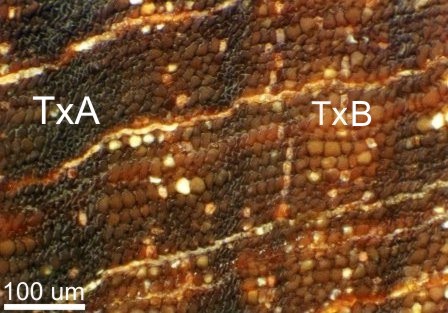 Textinite (Tx); reflected light, oil immersion.
Textinite (Tx); reflected light, oil immersion.
|
|
| Ulminite (U) Denotes the cell walls of more or less gelified tissues |
A (dark) and B (light) |
 Ulminite (U); reflected light, oil immersion.
Ulminite (U); reflected light, oil immersion.
|
|||
| Detrohuminite Consists of fine humic fragments ( |
Attrinite (A) Consists of a mixture of fine huminitic particles ( different shape and spongy to porous, ungelified amorphous huminitic substances |
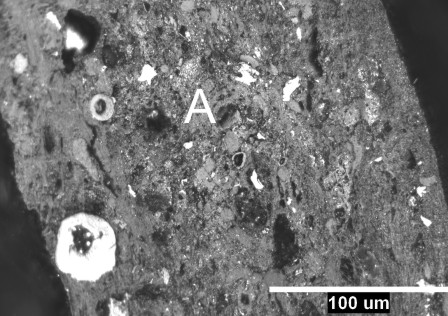 Attrinite (A); reflected light, oil immersion.
Attrinite (A); reflected light, oil immersion.
|
|||
|
Densinite (D) Consists of fine huminitic particles ( |
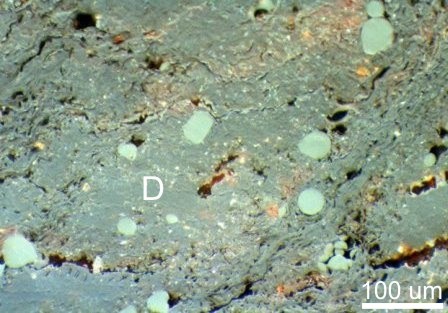 Densinite (D); reflected light, oil immersion.
Densinite (D); reflected light, oil immersion.
|
||||
|
Gelohuminite Comprises macerals originating from amorphous humic matter |
Corpohuminite Consists of homogenous, discrete bodies of former humic cell fillings occurring in situ with textinite or ulminite or isolated within attrinite, densinite, or clay |
Phlobaphinite (Ph) Originates from tannin-rich cell excretions, deposited in cortical cells, in parenchyma-tous or medullary-ray cells and especially in cork tissues |
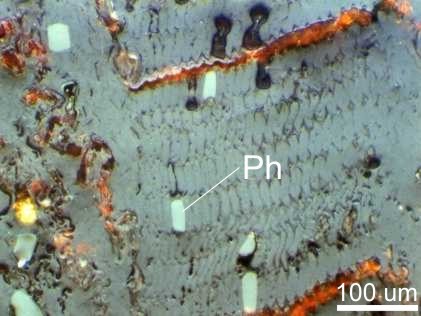 Pholbaphinite (Ph); reflected light, oil immersion.
Pholbaphinite (Ph); reflected light, oil immersion.
|
||
| Pseudophlobaphinite (Pd) Derives from colloidal humic solutions |
 Pseudophlobaphinite (Pd); reflected light, oil immersion.
Pseudophlobaphinite (Pd); reflected light, oil immersion.
|
||||
|
Gelinite Appears under reflected light as homogenous structureless or porous substance of huminitic reflectance |
Levigelinite (L) Completely structureless, compact, and homogenous |
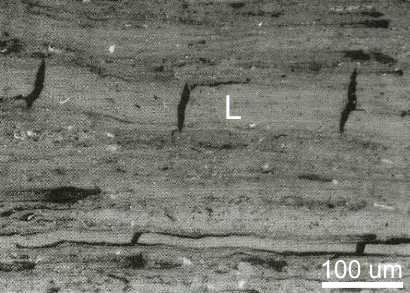 Levigelinite (L); reflected light, oil immersion.
Levigelinite (L); reflected light, oil immersion.
|
|||
| Porigelinite (Pg) Spongy, porous, or microgranular texture |
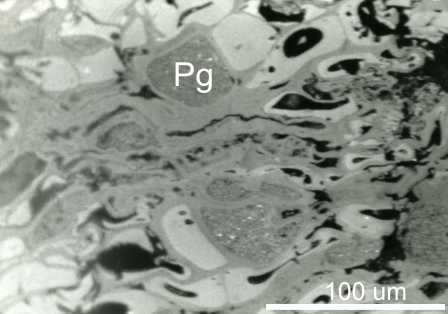 Porigelinite (Pg); reflected light, oil immersion.
Porigelinite (Pg); reflected light, oil immersion.
|
||||
| BITUMINOUS COALS AND ANTHRACITES | |||
|---|---|---|---|
| MACERAL GROUP | MACERAL SUBGROUP | MACERAL | MACERAL EXAMPLE |
|
VITRINITE
Derived from coalified woody tissue |
Telovitrinite Comprises vitrinites with preserved botanical cell structures which may or may not be visible |
Telinite (T) Consists of clearly recognizable cell walls of more or less intact plant tissue |
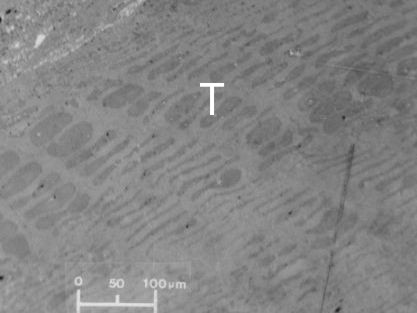 Telinite (T); reflected light, oil immersion.
Telinite (T); reflected light, oil immersion.
|
|
Collotelinite (C) Consists of more or less homogenized vitrinite layers which may exhibit poorly defined structure |
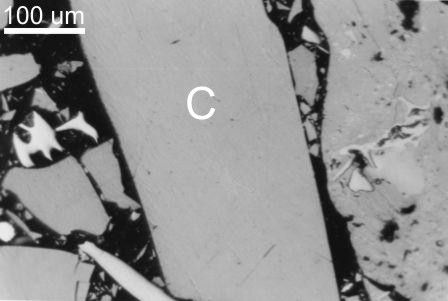 Collotelinite (C); reflected light, oil immersion.
Collotelinite (C); reflected light, oil immersion.
|
||
|
Detrovitrinite Consists of finely fragmented vitrinized plant remains occuring either isolated or cemented by amorphous vitrinic matter |
Vitrodetrinite (V) Occurs as discrete small vitrinitic fragments of varying shape that become discernible when surrounded by non-vitrinitic material |
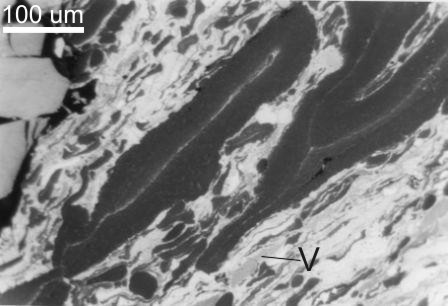 Vitrodetrinite (V); reflected light, oil immersion.
Vitrodetrinite (V); reflected light, oil immersion.
|
|
| Collodetrinite (Cd) Occurs as a mottled vitrinitic ground mass binding other coal components |
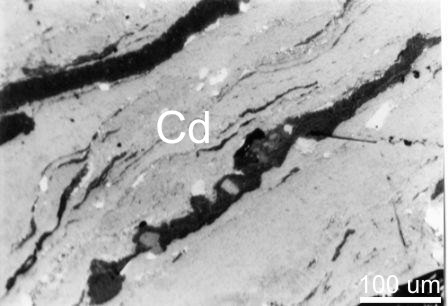 Collodetrinite (Cd); reflected light, oil immersion.
Collodetrinite (Cd); reflected light, oil immersion.
|
||
| Gelovitrinite Consists of colloidal fillings of vitrinitic material in former voids |
Corpogelinite (Cg) Consists of homogenous and discrete bodies representing cell infillings |
 Corpogelinite (Cg); reflected light, oil immersion.
Corpogelinite (Cg); reflected light, oil immersion.
|
|
| Gelinite (G) Consists of homogenous and structureless infillings of cracks and other voids |
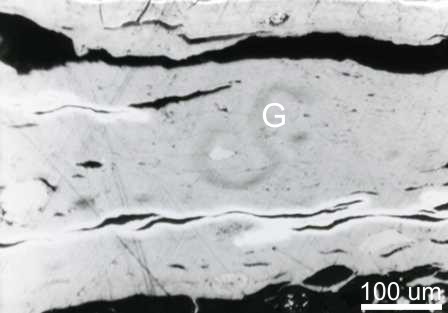 Gelinite (G); reflected light, oil immersion.
Gelinite (G); reflected light, oil immersion.
|
||
| Liptinite Group | |||
|---|---|---|---|
| MACERAL | MACERAL EXAMPLE | ||
|
Sporinite (S) Derived from the waxy coating of fossil spores and pollen |
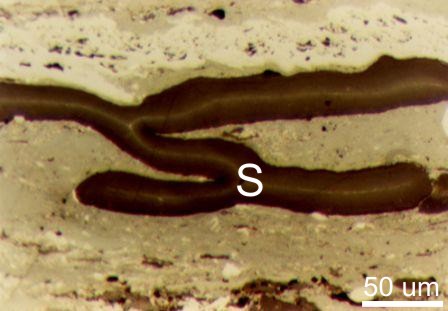 Sporinite (S); reflected light, oil immersion.
Sporinite (S); reflected light, oil immersion.
|
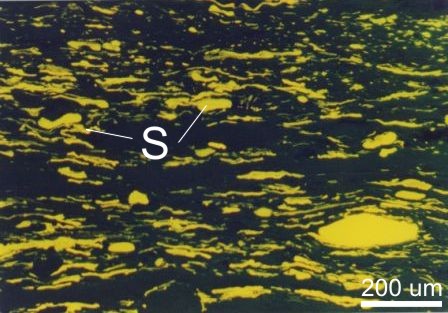 Sporinite (S); fluorescent light.
Sporinite (S); fluorescent light.
|
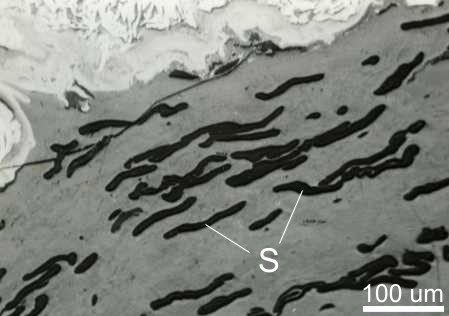 Sporinite (S); reflected light, oil immersion.
Sporinite (S); reflected light, oil immersion.
|
| Cutinite (Cu) Derived from the waxy outer coating of leaves, roots, and stems |
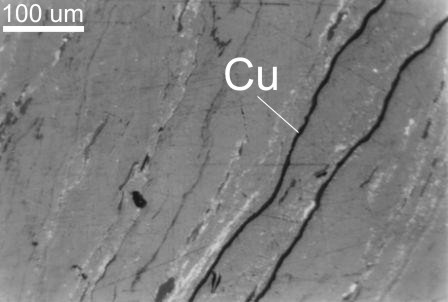 Cutinite (Cu); reflected light, oil immersion.
Cutinite (Cu); reflected light, oil immersion.
|
||
| Resinite (R) Derived from plant resins |
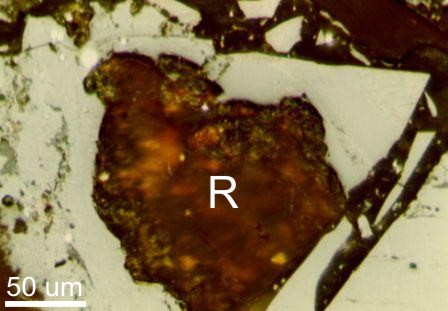 Resinite (R); reflected light, oil immersion.
Resinite (R); reflected light, oil immersion.
|
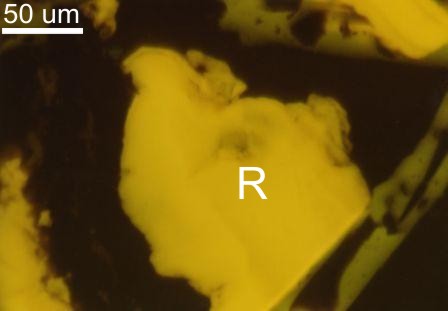 Resinite (R); fluorescent light.
Resinite (R); fluorescent light.
|
|
| Alginite (Ag) Derived from algae |
 Alginite (Ag); reflected light, oil immersion.
Alginite (Ag); reflected light, oil immersion.
|
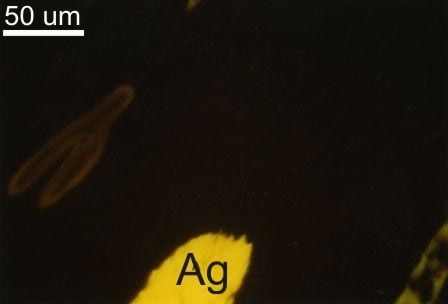 Alginite (Ag); fluorescent light.
Alginite (Ag); fluorescent light.
|
|
| Liptodetrinite (Ld) Occurs as discrete small liptinite fragments of varying shape |
 Liptodetrinite (Ld); fluorescent light.
Liptodetrinite (Ld); fluorescent light.
|
||
| Suberinite (Sb) Cork cell walls |
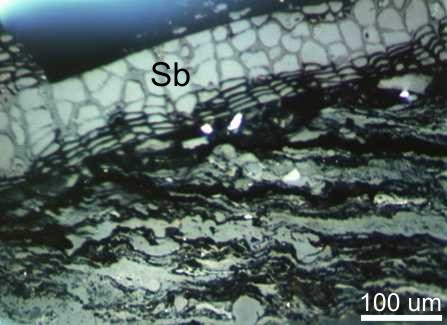 Suberinite (Sb); reflected light, oil immersion.
Suberinite (Sb); reflected light, oil immersion.
|
||
|
Chlorophyllinite Chlorophyl-derived material occurring in peat and very low maturity lignite. Not present above subbituminous coals. |
Picture not available | ||
| Exsudatinite (E) Secondary maceral filling cracks and cell lumens, originating after oil generation |
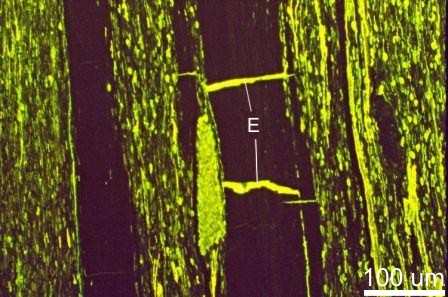 Exsudatinite (E); fluorescent light.
Exsudatinite (E); fluorescent light.
|
||
| Fluorinite (Fl) Semi-globular occurrences of fluorescing droplets (oil precursors?) |
 Flourinitie (Fl); fluorescent light.
Flourinitie (Fl); fluorescent light.
|
||
| Inertinite Group | |
|---|---|
| MACERAL | MACERAL EXAMPLE |
|
Micrinite (Mi) Occurs in very small rounded grains of high reflectance. It might originate from liptinites as a coalification product |
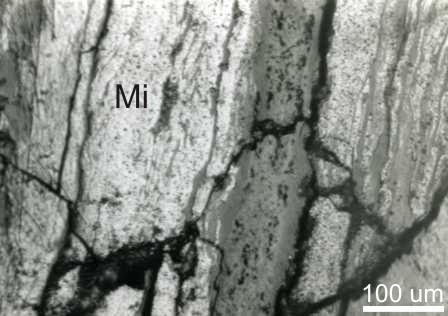 Micrinite (Mi); reflected light, oil immersion.
Micrinite (Mi); reflected light, oil immersion.
|
|
Macrinite (Ma) Occurs either as an amorphous matrix or as discrete, structureless bodies of variable shapes; probably originates from flocculated humic matrix substances |
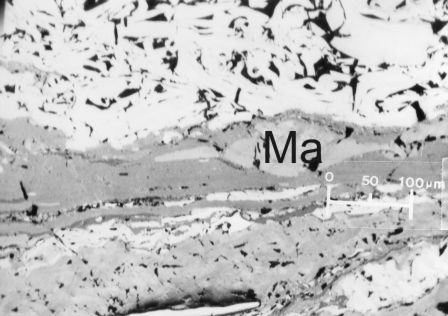 Macrinite (Ma); reflected light, oil immersion.
Macrinite (Ma); reflected light, oil immersion.
|
|
Fusinite (F) Shows highly reflecting, well-preserved cellular structure; originates from ligno-cellulosic cell walls |
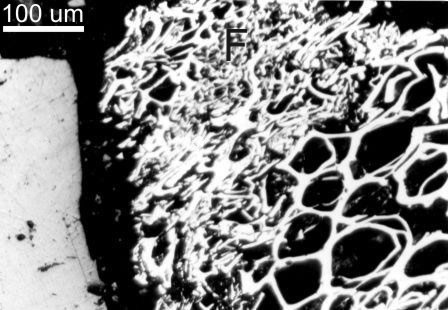 Fusinite (F); reflected light, oil immersion.
Fusinite (F); reflected light, oil immersion.
|
|
Semifusinite (Sf) Shows intermediate reflectance and partially visible cellular structure; originates from the parenchymatous and xylem tissues of stems, herbaceous plants, and leaves, which are composed of cellulose and lignin |
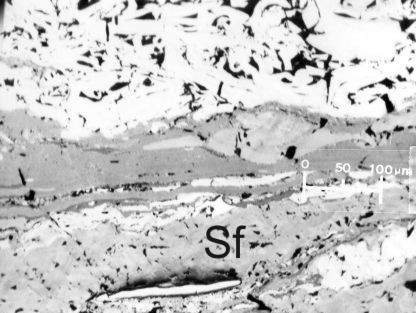 Semifusinite (Sf); reflected light, oil immersion.
Semifusinite (Sf); reflected light, oil immersion.
|
|
Secretinite (Sc) Composed of commonly round, and equant to elongate bodies without obvious plant structure; commonly considered to be an oxidation product of resin but it may originate from humic gels |
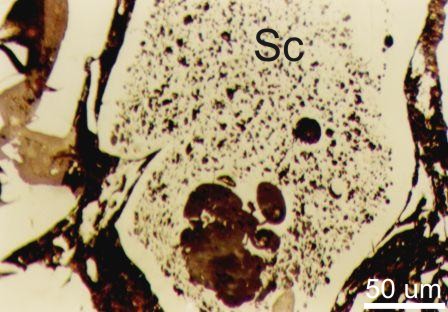 Secretinite (Sc); reflected light, oil immersion.
Secretinite (Sc); reflected light, oil immersion.
|
|
Funginite (Fg) Consisting mainly of high reflecting single- or multi-celled fungal spores, sclerotia, hyphae and mycelia (stromata, mycorrhiza), and other fungal remains |
 Funginite (Fg); reflected light, oil immersion.
Funginite (Fg); reflected light, oil immersion.
|
| Inertodetrinite (I) Occurs as discrete small inertinite fragments of varying shape |
 Inertodetrinite (I); reflected light, oil immersion.
Inertodetrinite (I); reflected light, oil immersion.
|
References
International Committee for Coal and Organic Petrology (ICCP), 1998.
The new vitrinite classification
(ICCP System 1994), reprinted from Fuel 77, p. 349-358, with permission from Elsevier.
International Committee for Coal and Organic Petrology (ICCP), 2001.
The new inertinite classification
(ICCP System 1994), reprinted from Fuel 80, p. 459-471, with permission from Elsevier.
Sykorova, I., Pickel, W., Christanis, K., Wolf, M., Taylor, G.H., Flores, D., 2005.
Classification of huminite
(ICCP System 1994) reprinted from International Journal of Coal Geology 62, p. 85-106, with permission from Elsevier.


